Last updated on January 29th, 2022
An animal with a long neck may look elegant or maybe gauche, don’t you think that they are fascinating anyway? Longer necks make up an exception, and we all usually tend towards the things that aren’t very common.
In this article, you may come across a snake-like turtle or maybe necks taller than any person you’ve ever met; despite their neck length, these animals have other interesting facts that just might be worth your interest.
Here are 21 animals that have long necks.
| Common Name | Scientific Name | Neck Length |
|---|---|---|
| 1. Cassowary | Casuarius | 12 inches |
| 2. Alpacas | Vicugna pacos | 25 inches |
| 3. Eastern Long-necked Turtle | Chelodina longicollis | 6 inches |
| 4. Herons | Ardeidae | 18 inches |
| 5. Gazelles | Gazella | 11 inches |
| 6. Flamingos | Phoenicopterus roseus | 33 inches |
| 7. Trumpeter Swans | Cygnus buccinator | 60 inches |
| 8. Giraffes | Giraffa | 78 inches |
| 9. Common Cranes | Grus grus | 16 inches |
| 10. Mule Deer | Odocoileus hemionus | 13 inches |
| 11. Emu Bird | Dromaius novaehollandiae | 19 inches |
| 12. Horses | Equus caballus | 36 inches |
| 13. Camels | Camelus | 56 inches |
| 14. Great Egrets | Ardea alba | 19 inches |
| 15. Ostriches | Struthio camelus | 39 inches |
| 16. Llamas | Lama glama | 24 inches |
| 17. Vultures | Cathartes aura | 11 inches |
| 18. Antelopes (Gerenuk) | Litocranius walleri | 15 inches |
| 19. Dachshunds | Canis lupus familiaris | 11 inches |
| 20. Pelicans | Pelecanus | 17 inches |
| 21. Donkeys | Equus asinus | 20 inches |
1. Cassowary

The neck length of a cassowary is approximately 12 inches.
Unlike humans, Cassowaries usually don’t mate for life, but the females usually mate with several males respectively during the breeding season; after laying the eggs, the mother takes off, and the responsibility of the eggs falls onto the shoulders of the father and he will have to incubate it for 50 days.
These birds are shy, omnivorous, flightless, and the females are brighter and larger than the male.
It has distinct varieties; the largest ones are the southern Cassowaries, it’s about 5.8 feet or 170 cm tall, and the females weigh up to 76 kg or 167 pounds, whereas the males are about 55 kg or 121 pounds.
These creatures also have a notably tall, bright blue and red neck, accompanied by 2 red wattles with a length of 7 inches or 17.8 cm. The neck also possesses glimmering black-colored feathers.
2. Alpacas

The neck length of an alpaca is approximately 25 inches.
Don’t confuse alpacas with llamas. Although they are similar in appearance, alpacas are smaller in size. These two species have the potential to cross-breed, though.
Alpacas are smart enough to use body language for communication. In addition, their population has grown drastically over the years, and surprisingly, they were almost endangered creatures.
They look like hairy camels with long necks but no humps. Their ears are also considerably longer, and their height is somewhere around 100-115 cm.
In the Andes, Alpaca can be an easy hunt for carnivores like bears or lions if they didn’t have such a long neck to spot these hunters hidden amid the rocks.
3. Eastern Long-necked Turtle
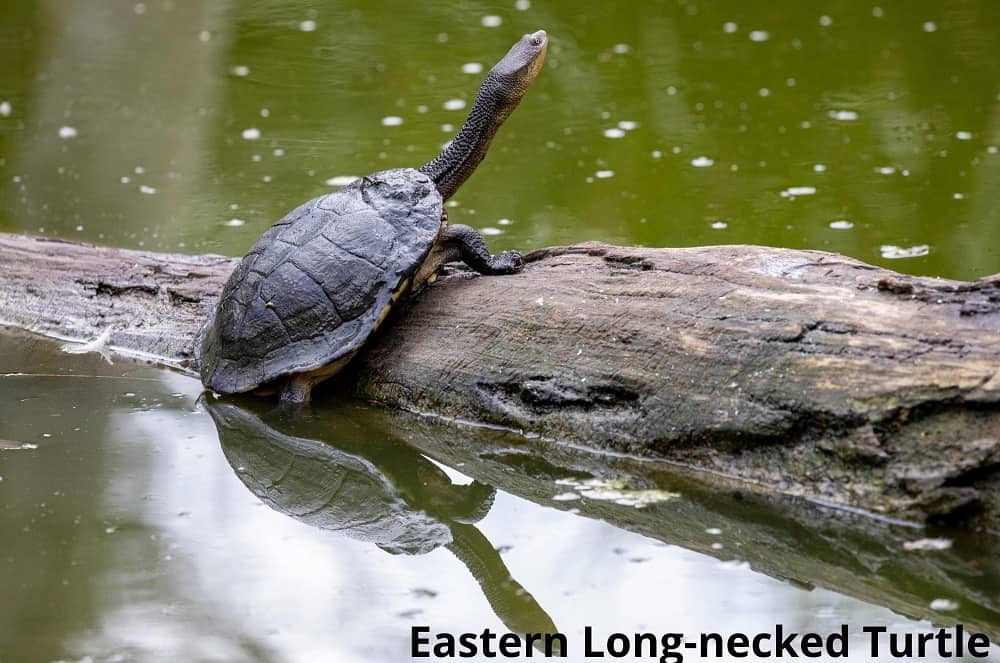
The neck length of an eastern long-necked turtle is approximately 6 inches.
I’m sure that you’re familiar with turtles, but have you ever wondered how they will look with a long neck?
That’s literally what it is; this snake-necked turtle species is an habitant of East Australia. Their carapace color varies from mostly black to light brown.
Their neck is long but narrow, and the length is roughly equal to 60 percent of that of its carapace. Additionally, the shell will grow to an average of 20 to 30 cm in its lifetime.
The neck color dorsally varies to dark grey from black, and ventrally is yellow. Females have deeper bodies and are usually larger than males.
Their sizes differ in different places; females grow up to 28.2 cm and males up to 24.9 cm.
4. Herons

The neck length of a heron is approximately 18 inches.
Herons are freshwater birds that can astound you by reaching a speed of 48 km or 30 miles per hour; their neck curves to an s-shape during the flight, while their long legs dangle behind.
The heron’s neck can extend and retract even while flying because the cervical vertebrae have a modified shape.
They also have long beaks and are usually found in medium to large sizes. Additionally, the heron bird belongs to the Ardeidae family and has variations like the grey heron and the great blue heron.
These coastal birds take advantage of their neck and legs to hunt fish for their living.
5. Gazelles

The neck length of a gazelle is approximately 11 inches.
Gazelles can attain a speed up to 100km or 60 miles per hour, although for sustained periods, they can run at a speed of 50 km or 30 miles per hour.
These swift animals usually live in herds and feed upon easily digestible herbivorous food.
Gazelles can be found in different varieties and the dama gazelle has a comparatively longer neck and legs. From the shoulder, its height is about 90 to 120 cm or 35 to 47 inches.
It is also believed to be the largest species of gazelle alive and it also has medium-sized ringed horns that are uncommon among other gazelles.
6. Flamingos
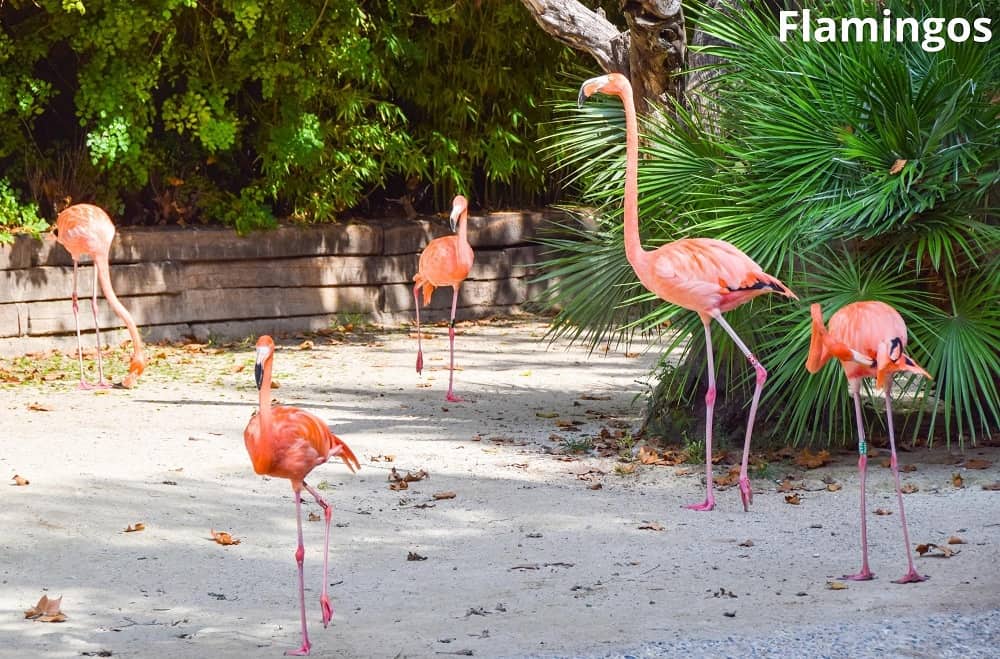
The neck length of a flamingo is approximately 33 inches.
Flamingos are wading birds that generally stand on a single leg, while the other is tucked underneath the body.
There is no concrete proof behind this practice, but it’s assumed that it helps them to sustain their body heat.
There are six different types of flamingo, and the tallest one is the greater flamingo that can reach a height of somewhere between 3.9 to 4.7 feet or 1.2 to 1.4 meters.
These birds are capable of flying and their long neck can help them get food in shallow as well as deep waters. Its s-shaped neck is pretty flexible for its nineteen elongated cervical vertebrae.
7. Swans

The neck length of the trumpeter swan is approximately 60 inches whereas the mute swan has an average neck length of 57 inches.
Just like humans, swans mostly do consider mating for life, although due to some undesirable circumstances like the failures in nesting can stem something like a divorce. Else if a mate dies, then the other finds a new one.
These are one of the largest flying birds, and its largest varieties like the trumpeter swan or mute swan can even cross the height of 1.5 m and weight of 15 kg or 33 lbs.
The black-necked swan has a white body and as the name suggests, a black neck. The necks of Swans are long, and the one with the longest neck is the black swan, which is mostly seen in an s-shaped.
They use their long neck to search for food both on land and in water.
8. Giraffes
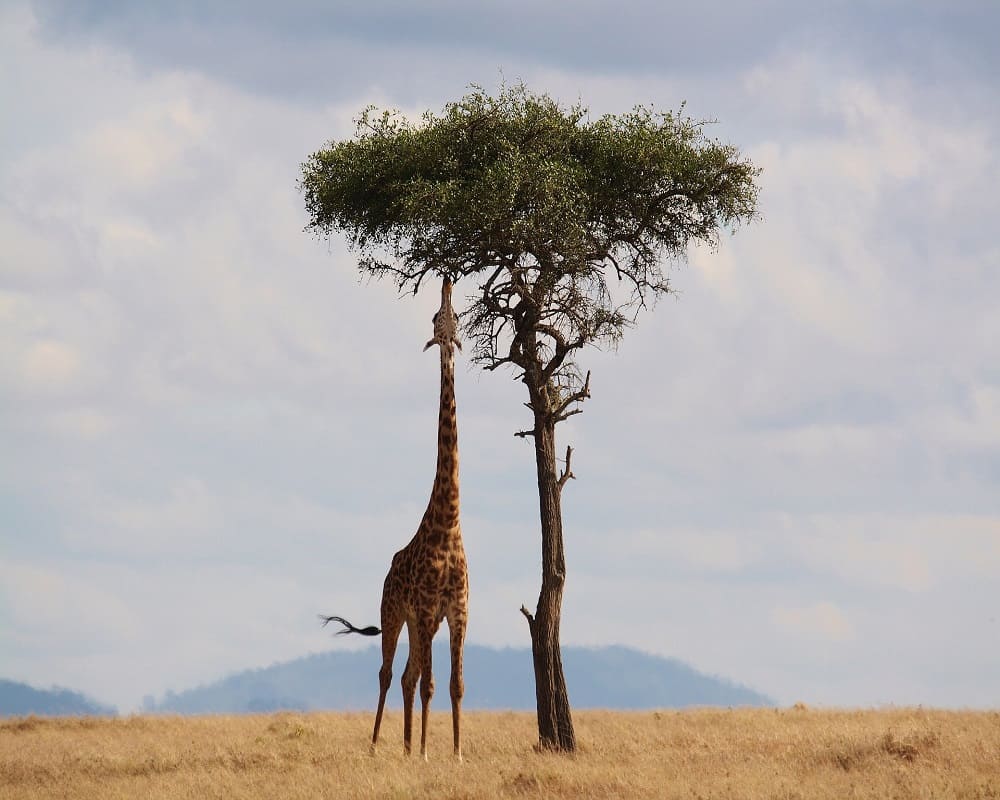
The length of a giraffe’s neck can approximately reach up to 78 inches (6.5 feet) or higher.
There is no room for confusion on this one, they are the tallest living land animal, and it’s mostly for their extremely long neck and legs.
An adult giraffe is about 4.3 to 5.7 meters tall and the males are usually taller than the females. If you remove their uncommonly long legs and neck, then the remaining body is comparatively short.
The darker the male giraffe seems, the older he has grown, and its front and back legs are approximately the same in length, and these legs are capable of sprinting up to 60 km or 37 miles per hour.
9. Common Cranes

The neck length of a crane is approximately 16 inches.
Cranes look identical to herons but aren’t related; a notable difference between them is that Cranes don’t pull back their neck to an s-shape while flying; they tend to keep it outstretched.
Due to their large size, Cranes are often referred to as the world’s tallest flying birds.
Different species have different sizes, and the sarus crane can be 69 inches or 176 cm tall, but the demoiselle crane stands only 35 inches or 90 cm tall.
They have long legs and necks, with large wings and a streamlined body. The males are usually a little larger than females, and their diet changes with the season.
10. Deer

The neck length of a mule deer is approximately 13 inches.
Deer can be easily differentiated from an antelope by their antlers and horns; even though their body appears to be similar, they have strong legs and large ears.
They have over 60 distinct species, the largest of them in existence is the moose that stands roughly 2.6 m or 8.5 feet tall.
In most of the species, usually, the males grow larger than the females, and the females also don’t have antlers; only reindeer are an exception here.
The Chinese water deer is the only deer, which misses upon antlers. These animals also tend to have long necks. A mule deer’s neck circumference varies from 12 to 25 inches and its overall body length is 49 to 66 inches.
11. Emu Birds

The neck length of the emu bird is approximately 19 inches.
No other bird except the Ostrich can beat Emu in terms of height, and it can stand tall up to 150 to 190 cm or 59 to 75 inches.
Females usually tend to be a bit larger than males and they are flightless birds, but they have vestigial wings.
Their long legs are capable of achieving the speed of 48 kilometers or 30 miles per hour, although their feet have 3 toes that indicate a lower number of bones and the respective foot muscles.
They can use their tall neck to spot predators or potential threats from a distance, even if they try to hide behind the tallest of the grasses.
12. Horses

The average neck length of a horse is 36 inches.
A long neck helps them to create balance while running; usually, the ratio of the length of the head to neck should be 1:1.5.
The hair which grows at the top of its neck is called the mane; the neck consists of over 100 muscles and a total of 7 cervical vertebrae.
The horse is a cursorial organism that helps it to outrun many of the predators, an interesting fact about them is their ability to sleep at both standing and lying positions.
13. Camels
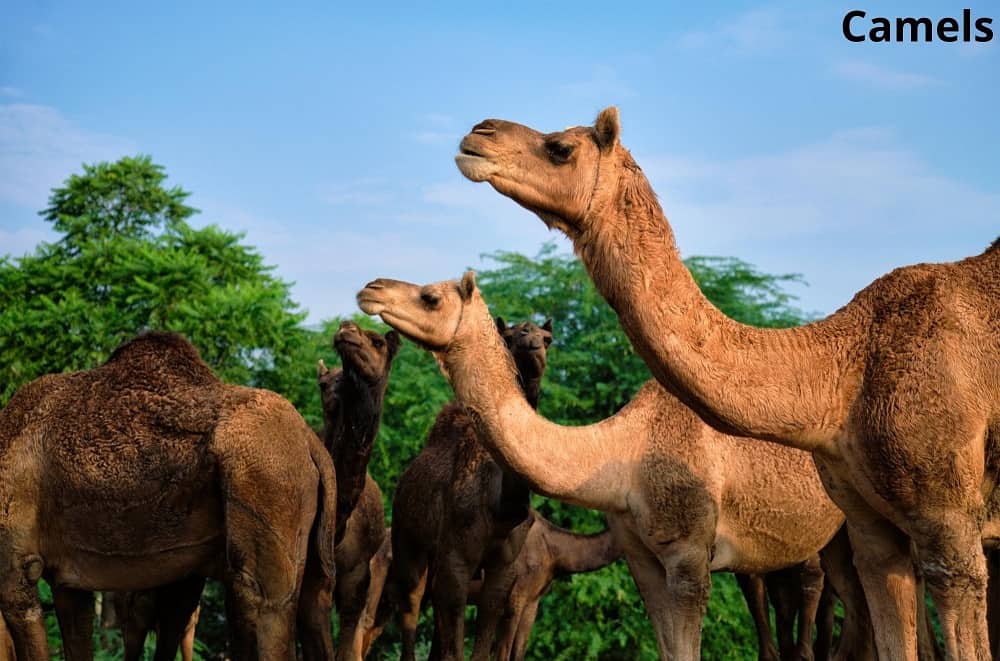
The neck length of a camel is approximately 56 inches.
Camels are even-toed ungulates, and they usually tend to be well adapted to deserts. They can be raised both for meat and milk.
Their milk is rich in calcium that can lead to greater bone strength and height growth.
An adult camel stands 6 ft 1inch or 1.85 m tall, and if measured from the hump, they stand 7 ft 1 inch or 2.15 m taller.
It can achieve a speed of 65 km or 40 miles per hour for short durations.
A masculine dromedary camel has a pink organ in its throat, named dulla, and the males use it while courtship by laying out the dulla from their mouth.
It has crazy long necks, although these are helpful for them to reach the tree leaves that are a lot higher from the ground.
14. Great Egrets

The neck length of an egret is approximately 19 inches.
Egrets are herons; there is no biological difference; they just look different. Despite having the same build, egrets usually have white plumage; they develop fine plumes, mostly milky white plumes for the breeding season.
They look elegant and beautiful in the milky white color and can be found hunting or living in both freshwater and saltwater marshes.
There are different species of Egrets, most of them are smaller than herons, but some are larger.
The great egret has both long legs and an s-curved neck, just like herons, and its length is around 94 cm to 104 cm or 37 inches to 40.9 inches.
15. Ostriches
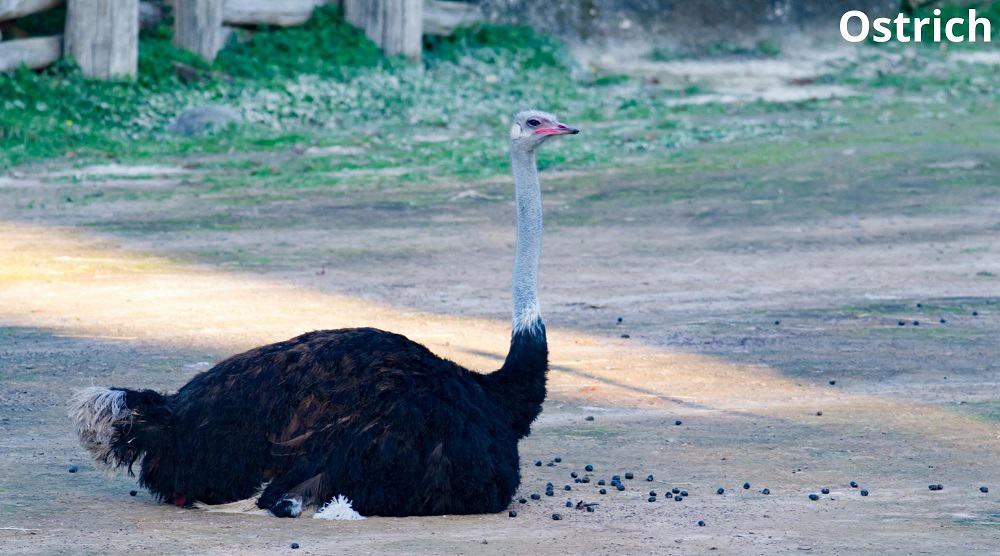
The neck length of an ostrich is approximately 39 inches.
No other bird is as large as the Ostrich, and no other land animal can produce as large eggs as this one; they can’t fly but can beat any land bird in terms of speed.
They are also the heaviest birds alive, and the two living species of it are the Somali Ostrich and common Ostrich. Seven known species of it couldn’t save themself from extinction.
Their necks are sensationally tall with a length of a meter and flexible. They can spot predators from a distance, and with their long legs, they have an option to run.
An ostrich’s neck consists of 19 vertebrae and that sounds crazy as giraffes have only 7.
16. Llamas

The neck length of a llama is approximately 24 inches.
An adult llama, from the top of the head, can stand up to 1.7-1.8 m tall and weigh 130-200 kg or 290-440 lbs. Llamas have long necks that help them make balance while climbing; it has 7 cervical vertebrae.
Llamas are useful for their meat and they are capable of carrying 25 to 30% of their body weight for a distance of 5 to 8 miles or 8-13 km.
This animal has great significance in the Aymara mythology; it is said that at the end of time, llamas will go back to the lagoons and water springs from where they came.
17. Vultures
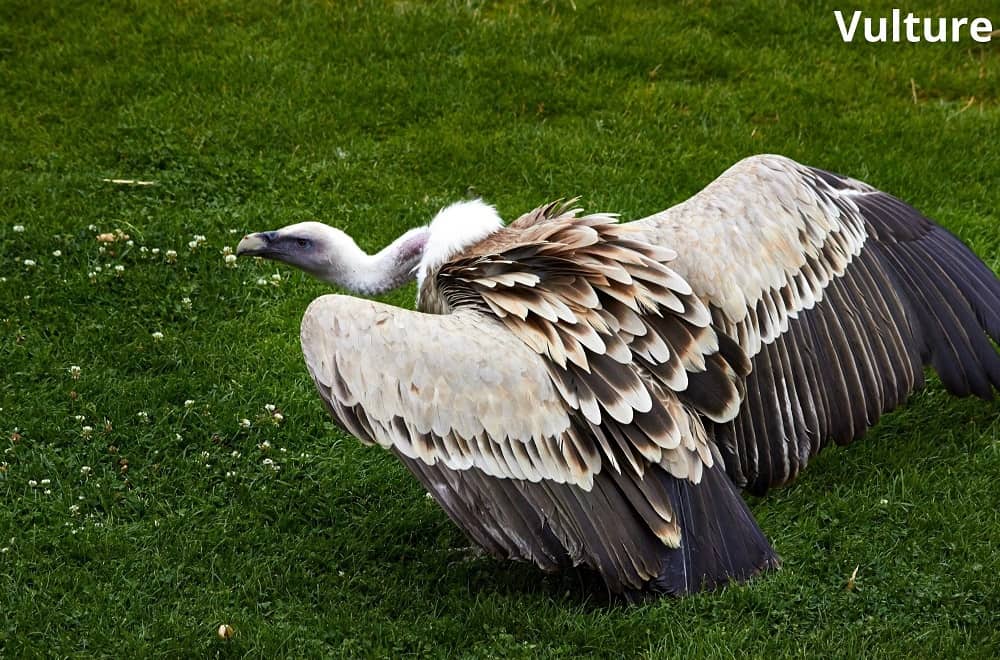
The neck length of a vulture is approximately 11 inches.
In the heat, this bird of prey tends to stretch its neck and open its wings; there are the Old World Vultures and New World Vultures; they aren’t very much related, although at first they were placed under a single group.
They look similar for convergent evolution, but the New Word Vultures have comparatively weaker feet.
They possess a huge pouch in their throat and are capable of surviving for long periods without food.
A vulture’s body length is about a meter long, and it has a long neck; ancient Egyptians considered it to be pure as they thought all the vultures were female and were born without any contribution of the male.
18. Antelopes (Gerenuk)
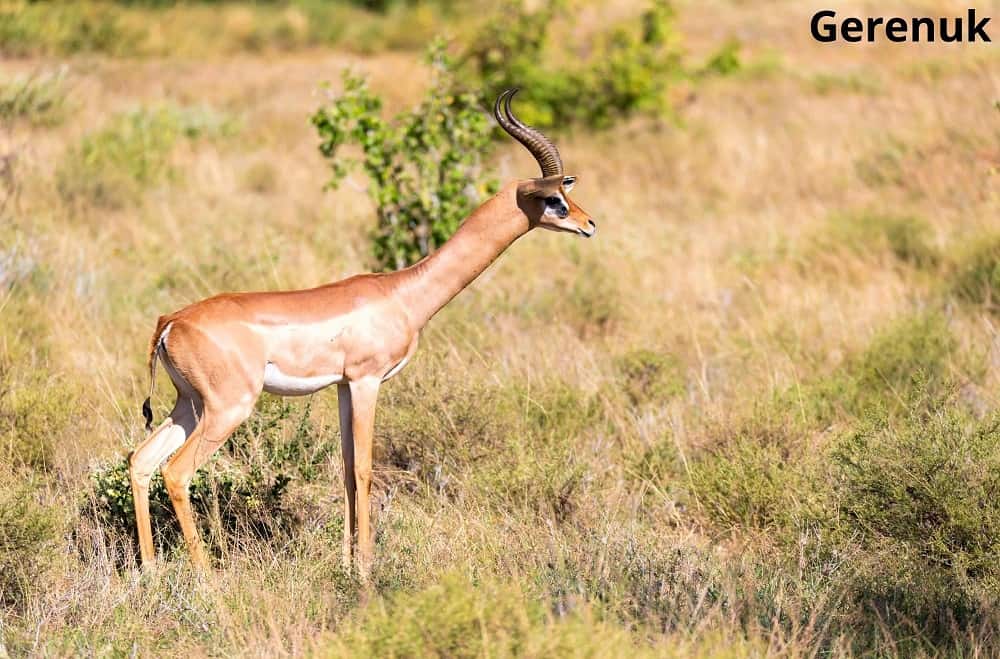
The neck length of a gerenuk (a slender and tall antelope) is approximately 15 inches.
Antelopes are even-toed ruminants, unlike the antlers of deer; antelopes possess horns that are permanent and aren’t shed and grown yearly.
They have a vast species, and there is a significant difference in their sizes.
For instance, a giant eland’s length is between 86.5 to 114 inches or 220 to 290 cm, whereas the royal antelope that stands only 25 cm tall seems tiny in front of it. Due to their strong and capable legs, they are fast runners.
Kudus and elands can even jump over 2.4 m; an antelope with a long neck is the gerenuk, also referred to as giraffe gazelle; it is unique for its exceptionally long neck.
It is 80 to 105 cm tall, and the head-and-body length sums up to 140 to 160 cm. Its slender neck helps it enjoy the high-growing plants, unlike other antelopes who rely upon the grass and other ground plants.
19. Dachshunds

A standard dachshund has an average neck length of 11 inches.
Dachshunds are especially known for their short legs and long body; they are also popular as the sausage dog, badger dog, and wiener dog.
It has a long snout and three coat varieties- wire-haired, long-haired, and short-hair. They also vary in color, although the most common one is red.
They are also available in three sizes, kaninchen or rabbit-sized, miniature, and standard. An adult standard dachshund weighs around 7.5 to 14.5 kg or 16 to 32 lbs.
Fun fact: The dachshunds are also looked at traditionally as a symbol of Germany.
20. Pelicans

The neck length of a pelican is approximately 17 inches.
Pelicans are famous for their huge throat pouch and long beak; this combo serves as a net to catch fish and rainwater occasionally, however, they can’t use it as a lunchbox to carry food back to their nests as it can lead to dis-balance while flying.
They are one of the heaviest flying birds; they have short tails, long necks, and wings.
They possess 30 to 35 secondary flight feathers; the females are usually shorter than the males and have smaller bills.
It has various species; the tallest one is considered to be Dalmatian that is 1.83 meters in length, up to 15 kg in weight, whereas the smallest one is 1.06m in length and 2.75 kg in weight.
21. Donkeys

The neck length of a donkey is approximately 20 inches.
The donkey has been used for a minimum of 4000 years for working or domestic purposes. Just like horses, the younger donkeys are called foals.
The mating of male donkeys and female horses takes place for the production of mules.
Donkeys come in different sizes based on environmental conditions and distinct breeds.
At the withers, its height can be lesser than 90 cm to as high as 150 cm, and its body length is 145 to 193 cm and it has a long neck.
They are even stronger than horses of their size and they can survive for over 20 years.

